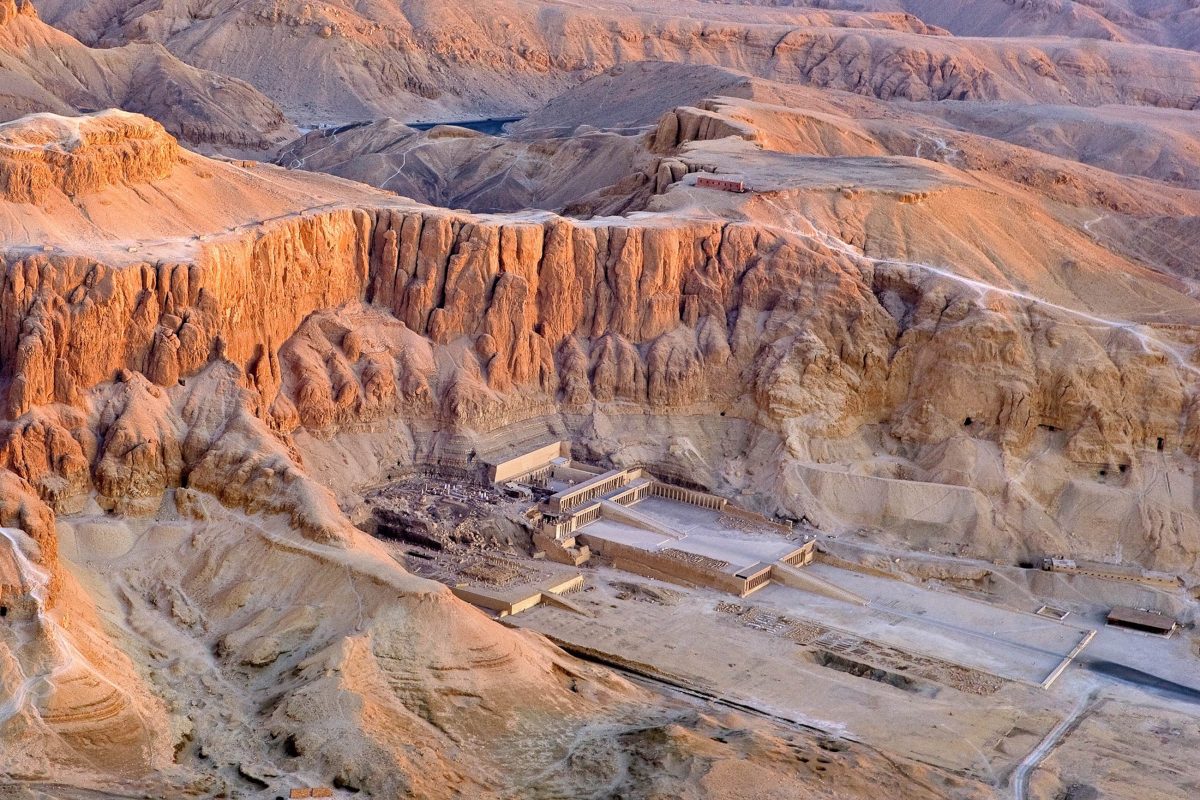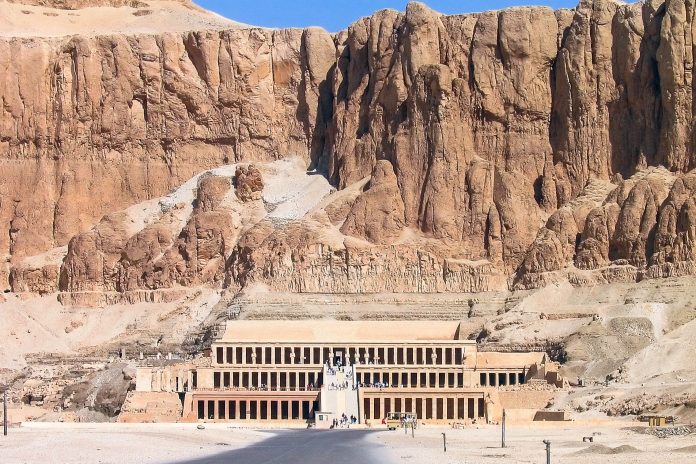Der Tempel der Hatschepsut ist eines der großartigsten Kulturdenkmäler Ägyptens. Neben seiner ungewöhnlichen Architektur sticht er vor allem hervor, weil seine Erbauerin die einzige Pharaonin Ägyptens war.
Der gewaltige Totentempel der Hatschepsut ist der am besten erhaltene Kalkstein-Tempel der 18. Dynastie und gehört zu unseren Top 10 Sehenswürdigkeiten von Ägypten. Schätzungsweise wurde die kolossale Tempelanlage etwa um 1500 vor Christus innerhalb von 15 Jahren durch den Architekten Senenmur errichtet.
Der Baumeister war gleichzeitig auch der Erzieher von Hatschepsuts Tochter und angeblich auch Hatschepsuts heimlicher Geliebter. Diese Umstände könnten die Ursache sein, dass es Senenmut erlaubt war, seine Grabstätte in unmittelbarer Nähe zum Tempel unter der ersten Terrasse zu erwählen. Bestattet wurde er dort jedoch nie.
Inhaltsverzeichnis
Wo liegt der Tempel der Hatschepsut?
Der Hatschepsut-Tempel liegt im Tal Deir el Bahari (beim einstigen Theben, heute Luxor) in der ägyptischen Wüste weit offen zum Nil und ist erster Linie den Göttern Hathor und Amun-Re geweiht. Wer die Felsklippe im ebenso berühmten Tal der Könige erklimmt, hat einen unvergesslichen Blick auf den Tempel aus der Vogelperspektive. Von Luxor aus dauert die Autofahrt zum Hatschepsut-Tempel rund 45 Minuten.
Vom Hatschepsut-Tempel führt eine schnurgerade Prozessionsstraße über den Taltempel der Hatschepsut zum Nilufer und weiter über den Fluss zum Karnak-Tempel – wohl eine der ersten „Autobahnen“ der Welt.
Was ist so besonders am Hatschepsut-Tempel?

Das bedeutendste Unterscheidungsmerkmal zu anderen Tempelanlagen Ägyptens ist wohl, dass der Tempel der Hatschepsut im Auftrag einer Frau erbaut wurde – von Hatschepsut selbst. Die einzige bekannte Pharaonin Ägyptens lernte das Streben nach Macht bereits in ihrer Kindheit von ihrem Vater Thutmosis I.
Nach der Heirat mit seinem Stiefsohn Thutmosis II und dessen frühen Todes war ihr Sohn, Thutmosis III. mit ca. 4 Jahren noch viel zu jung für den Herrschersitz. Vorübergehend übernahm diesen seine Mutter, bis sie mit allen bekannten Traditionen brach und sich selbst zur Herrscherin aufschwang – zum ersten und letzten Mal in der (bekannten) ägyptischen Geschichte.
Auch das gewaltige steinerne Vermächtnis der Pharaonin unterscheidet sich in seiner architektonischen Erscheinung von anderen Tempeln Ägyptens. Die charakteristischen Höfe wurden durch Terrassen ersetzt, die durch Rampen miteinander verbunden sind. Manche Experten sehen den Tempel als Vorläufer für die spätere Architektur der Griechen und Römer, theoretisch könnte der kolossale Tempel aber genauso ein moderner faschistischer Palast sein. Zweifellos gehört er zu den großartigsten Denkmälern der ägyptischen Kultur.
Über 2 Jahrzehnte regierte Hatschepsut über ganz Ägypten. Ihren Sohn Thutmosis III sah sie zwar offiziell als Mitherrscher, untergrub seine Macht aber regelmäßig. So rächte sich Thutmosis III. nach ihrem Tod offenbar, indem er ihr Andenken zerstören wollte. Die 37 Meter lange Rampe zum Portal des Tempels der Hatschepsut war ursprünglich von Sphinx-Statuen gesäumt, die nach Hatschepsuts Tod zertrümmert wurden. Auch einige Statuen und Reliefdarstellungen im Inneren des Tempels wurden stark beschädigt. Ob die Verwüstungen tatsächlich von ihrem Sohn oder vielleicht eher von einer eifersüchtigen Priesterschaft ausgingen, ist nicht rechtlos geklärt.
Erforschung des Hatschepsut-Tempels
Die ersten Europäer bekamen den Tempel etwa um 1740 zu Gesicht und nannten den Bau „Nördliches Kloster“. Die ersten Ausgrabungen bzw. Schutträumungen am Tempel der Hatschepsut geschahen Ende des 19. Jahrhunderts im Auftrag des Britisch Egypt Exploration Fund. Neben den Aufräumungsarbeiten der herabgestürzten Felsbrocken wurden auch die Wandmalereien im Tempel von Deir el Bahari kopiert und katalogisiert. Die Ausgrabungs- und Restaurierungsarbeiten sind bis heute noch nicht vollständig abgeschlossen.
Besuch des Hatschepsut-Tempels
Der Innenraum des Hatschepsut-Tempels beeindruckt heute noch vor allem durch die kunstvollen Wandmalereien, die überall im Tempel zu finden sind und in mühevoller Kleinstarbeit wiederhergestellt wurden. Hier wird auch sichtbar, dass Hatschepsut immer wieder als Mann dargestellt wurde – die Künstler von damals waren mit einem weiblichen Pharao scheinbar zum Teil überfordert.
Die beiden Kapellen in der Tempelanlage sind den Göttern Hathor, Amun-Re und Anubis geweiht und ebenfalls reich verziert. Es gibt auch eine Kapelle der Hatschepsut und des Thutmosis I, von wo aus man in das Sanktuar des Thutmosis I gelangt. Hier sind die Verzierungen leider beinahe vollständig zerstört. Im großen Hof des Sonnenheiligtums wurde ein Sonnenaltar errichtet. Bis auf eine Darstellung der Reise der Sonne über den Himmel ist dieses Heiligtum nicht dekoriert.
In den Hügeln um den Tempel herum sind eine Menge Löcher im Fels zu sehen, der Steilhang sieht regelrecht wie ein Schweizer Käse aus. Dies sind ehemalige Gräber, die Grabräuber nach ihre Plünderung offen zurück ließen.
Traurige Berühmtheit: Negative Schlagzeilen machte der Tempel der Hatschepsut, als im Jahr 1997 arabische Extremisten einen Anschlag verübten, dem 58 Touristen und 4 Ägypter zum Opfer fielen.
Weiterführende Links:
Beschreibung der Wandmalereien und Felsenbilder im Tempel der Hatschepsut





